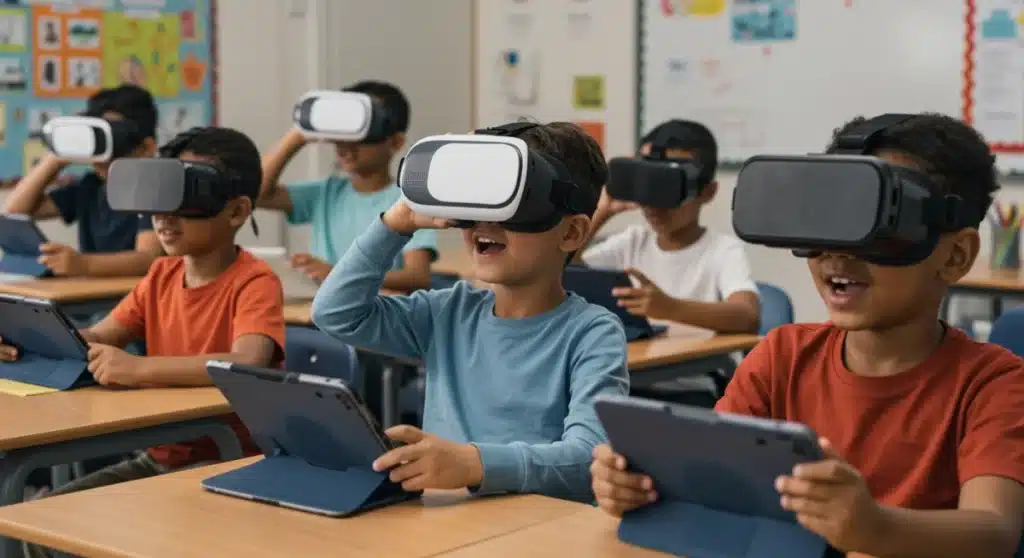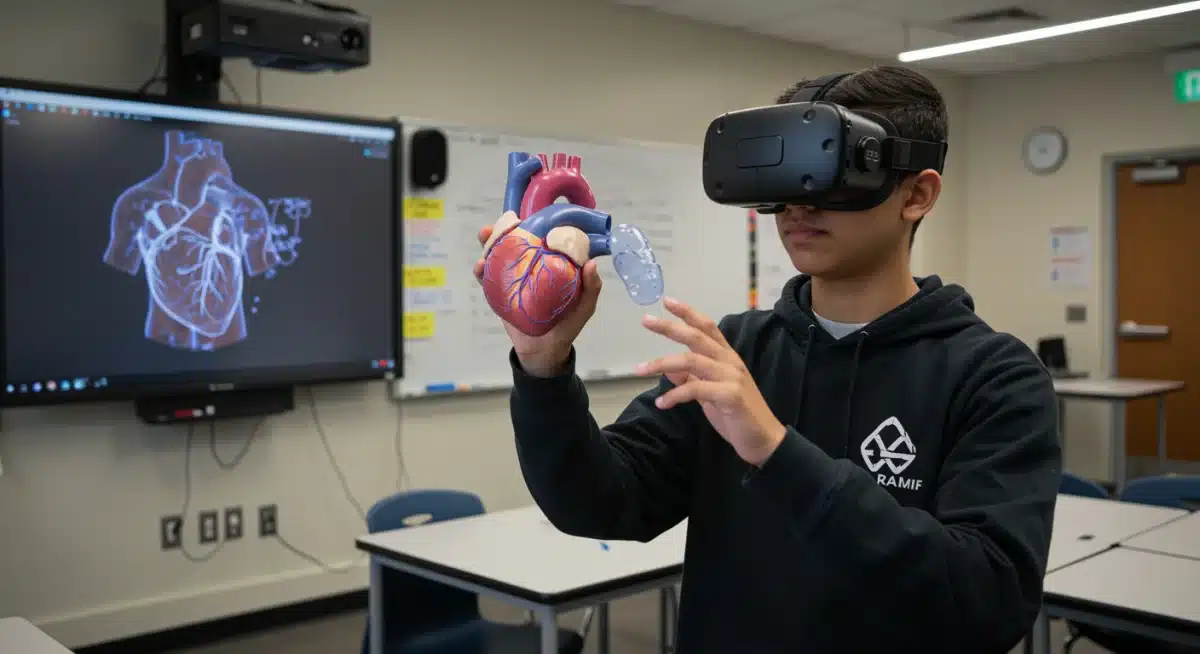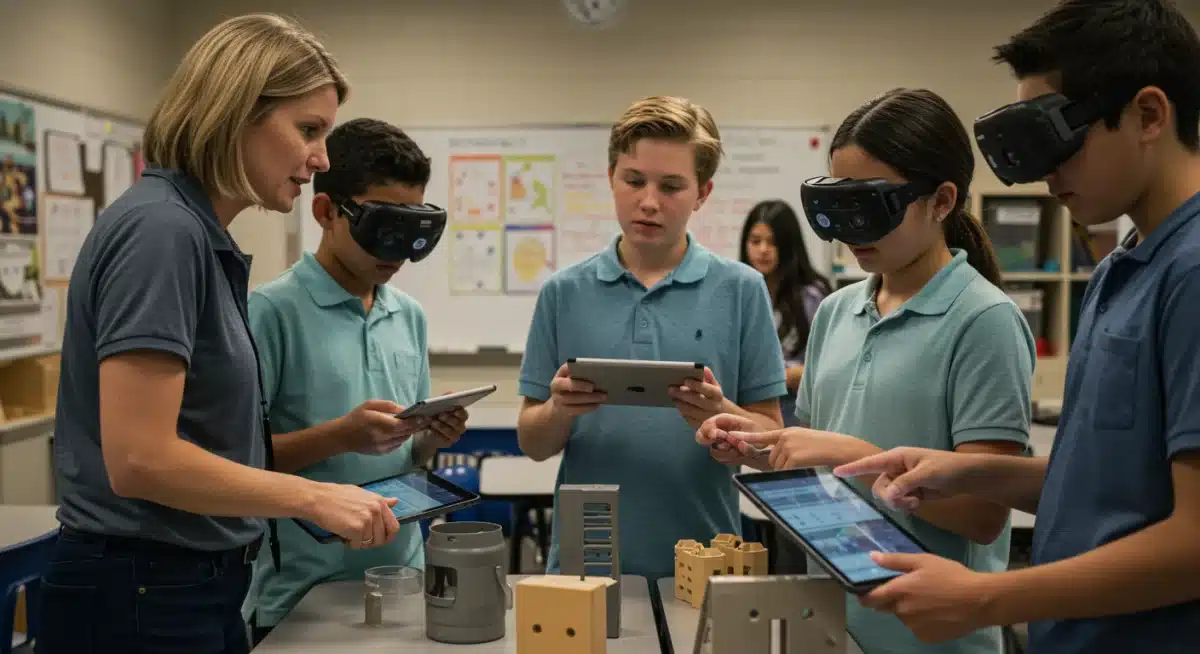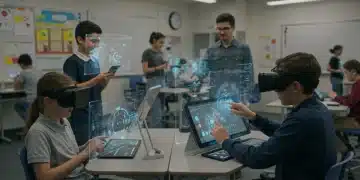VR/AR in US Education: Growth & Adoption by 2025

The role of VR/AR in education in US schools is projected for substantial growth and adoption by 2025, driven by technological advancements and a demand for innovative learning approaches.
The Role of VR/AR in Education: Expected Growth and Adoption in US Schools by 2025 is rapidly transitioning from a futuristic vision to a present-day reality. This shift promises to redefine pedagogical methods, offering immersive and interactive learning experiences that were previously unimaginable. As educators and policymakers in the US increasingly recognize the potential of these technologies, the stage is set for a transformative period in educational delivery.
The Current Landscape of VR/AR in US Education
The current integration of virtual reality (VR) and augmented reality (AR) technologies into US educational settings remains nascent but is quickly expanding. Early adopters, primarily in higher education and specialized K-12 programs, have demonstrated the profound impact these tools can have on student engagement and comprehension.
While widespread adoption is still a few years away, pilot programs and innovative initiatives are providing crucial insights into best practices and potential challenges. Institutions are experimenting with VR for field trips to inaccessible locations, AR for interactive textbook overlays, and mixed reality for vocational training simulations. The foundational work being laid now will determine the pace and scale of future integration.
Early Adoption and Pilot Programs
- Immersive Field Trips: VR allows students to explore historical sites, distant planets, or even the human body without leaving the classroom. This offers unparalleled access to experiences that would otherwise be impossible or cost-prohibitive.
- Interactive Learning: AR applications enhance traditional learning materials by overlaying digital content onto the real world, turning textbooks into dynamic, interactive experiences.
- Skill-Based Training: Vocational and technical schools are leveraging VR for realistic simulations, preparing students for careers in fields like healthcare, engineering, and manufacturing.
The feedback from these early programs consistently highlights improved student motivation, deeper understanding of complex subjects, and enhanced retention of information. These positive outcomes are fueling the demand for broader implementation and investment in VR/AR infrastructure across US schools.
Projected Growth and Market Trends by 2025
By 2025, analysts predict a significant acceleration in the adoption of VR/AR technologies within US educational institutions. This growth is not merely speculative; it is grounded in several key market drivers, technological advancements, and a growing understanding of the pedagogical benefits.
Lower hardware costs, increased accessibility of content creation tools, and robust research demonstrating efficacy are all contributing factors. Educational technology (EdTech) companies are increasingly focusing on developing VR/AR solutions tailored specifically for classroom environments, responding to the burgeoning demand from schools and districts looking to modernize their teaching methods.
Key Growth Drivers for VR/AR in Education
- Decreasing Hardware Costs: The price of VR headsets and AR devices is steadily declining, making these technologies more financially viable for schools with limited budgets.
- Content Development: A burgeoning ecosystem of educational VR/AR content developers is creating high-quality, curriculum-aligned experiences across various subjects.
- Teacher Training Initiatives: Professional development programs are emerging to equip educators with the skills needed to effectively integrate VR/AR into their lesson plans.
Reports from market research firms like Statista and Technavio consistently forecast double-digit annual growth rates for the VR/AR in education market. This indicates a strong trajectory towards widespread adoption, transforming how students learn and teachers teach across the United States. The emphasis on personalized and experiential learning is a major catalyst for this projected expansion.
Transforming Learning Experiences with Immersive Technology
The true power of VR/AR lies in its capacity to create deeply immersive and interactive learning experiences. Traditional teaching methods often struggle to convey complex concepts or provide hands-on practice; immersive technologies bridge this gap by placing students directly into simulated environments where they can explore, experiment, and learn by doing.
Whether it’s dissecting a virtual frog without ethical concerns, walking through ancient Rome, or manipulating molecules in a 3D space, VR/AR makes abstract ideas tangible and engaging. This level of interaction fosters a deeper understanding and retention of information, moving beyond rote memorization to genuine comprehension.
For example, a history lesson on the Civil War can become a virtual tour of Gettysburg, allowing students to witness key moments and understand the terrain’s impact on battle strategies. Science students can conduct experiments in a virtual lab, manipulating variables and observing outcomes in a safe, controlled environment. This hands-on approach caters to diverse learning styles and makes education more accessible and exciting for all.
Impact on Student Engagement and Retention
One of the most immediate and noticeable benefits of VR/AR in education is the dramatic increase in student engagement. The novelty and interactive nature of these technologies capture students’ attention, making learning feel less like a chore and more like an adventure. This heightened engagement directly correlates with improved academic performance and better long-term retention of learned material.
Furthermore, VR/AR can provide personalized learning paths. Students can progress at their own pace, revisit challenging concepts, and explore topics that pique their individual interests. This adaptive learning environment ensures that each student receives the support and stimulation they need to succeed.
Challenges and Considerations for Widespread Adoption
Despite the immense potential, the path to widespread adoption of VR/AR in US schools is not without its hurdles. Several challenges need to be addressed to ensure equitable and effective implementation across diverse educational landscapes.
Cost remains a significant barrier for many districts, particularly those in underserved areas. Beyond the initial hardware investment, there are ongoing costs associated with software licenses, content development, maintenance, and necessary infrastructure upgrades, such as high-speed internet and robust Wi-Fi networks. Additionally, the development of high-quality, curriculum-aligned content is still evolving, and not all subjects have an abundance of ready-to-use VR/AR resources.
Overcoming Implementation Obstacles
- Funding and Equity: Securing adequate funding and ensuring equitable access to VR/AR technologies for all students, regardless of socioeconomic background, is paramount. Grant programs and public-private partnerships can play a crucial role.
- Content Development: A continuous pipeline of high-quality, standards-aligned educational content is essential. Partnerships between EdTech companies and curriculum experts can accelerate this.
- Teacher Professional Development: Comprehensive training programs are needed to empower educators to effectively integrate VR/AR into their pedagogy. Teachers require support not just in using the technology but in designing lessons that leverage its unique capabilities.
Addressing these challenges requires a concerted effort from policymakers, school administrators, technology providers, and educators. Strategic planning, pilot program evaluation, and continuous feedback loops will be vital to navigating the complexities of integrating these powerful tools into the educational mainstream.

Policy and Funding Initiatives Supporting VR/AR Integration
Recognizing the transformative potential of VR/AR, various policy and funding initiatives are emerging at both federal and state levels to support its integration into US schools. These initiatives aim to address some of the financial and infrastructural barriers, paving the way for broader adoption by 2025.
Federal programs, such as those administered by the Department of Education, are increasingly allocating funds towards innovative educational technologies. State governments are also launching pilot programs and offering grants to school districts willing to experiment with VR/AR. These efforts are crucial for providing the initial capital needed for schools to invest in hardware, software, and teacher training.
Furthermore, educational technology consortia and non-profit organizations are playing a vital role in advocating for VR/AR in education, sharing best practices, and facilitating partnerships between schools and technology providers. These collaborations are essential for creating a supportive ecosystem that fosters innovation and addresses the unique needs of the education sector.
Key Policy Drivers and Support Mechanisms
- Federal Grants: Government funding opportunities specifically targeting educational innovation and technology integration are expanding, providing financial incentives for schools to explore VR/AR.
- State-Level Initiatives: Many states are developing their own strategic plans for EdTech, including provisions for VR/AR, to modernize their educational systems and prepare students for future careers.
- Research and Development Funding: Investment in research on the efficacy and best practices of VR/AR in education is crucial for building an evidence base that supports widespread adoption.
These policy and funding mechanisms are critical for accelerating the adoption curve. By reducing financial burdens and providing strategic guidance, they enable schools to confidently invest in VR/AR, ultimately benefiting students across the nation. The emphasis on data-driven decision-making ensures that these investments yield tangible educational outcomes.
The Future Classroom: A Vision for 2025 and Beyond
Looking ahead to 2025 and beyond, the vision of the future classroom in the US is one where VR/AR technologies are seamlessly integrated, becoming as commonplace as interactive whiteboards or laptops are today. This integration will not replace traditional teaching but rather augment it, providing powerful tools that enhance engagement, personalize learning, and prepare students for a rapidly evolving world.
Imagine classrooms where students collaborate on virtual projects with peers from around the globe, where scientific concepts are explored through hands-on virtual experiments, and where historical events are experienced first-hand through immersive simulations. This future promises a more dynamic, equitable, and effective learning environment for all.
Educators will evolve into facilitators of immersive experiences, guiding students through virtual worlds and augmented realities, fostering critical thinking, problem-solving, and creativity. The focus will shift from content delivery to experiential learning, empowering students to take ownership of their educational journey. The role of VR/AR in education US will be central to this evolution.
Expected Long-Term Impacts on Education
- Enhanced Digital Literacy: Students will develop advanced digital literacy skills, essential for success in a technology-driven world.
- Global Collaboration: VR/AR can break down geographical barriers, enabling students to collaborate with international peers on projects and cultural exchanges.
- Personalized Learning Paths: The adaptive nature of VR/AR will allow for highly personalized educational experiences, catering to individual learning styles and paces.
The journey towards this future classroom is ongoing, but the trajectory is clear. By 2025, the foundational elements for widespread VR/AR adoption will be firmly in place, setting the stage for a revolution in how education is conceived and delivered across US schools. This transformative period holds immense promise for future generations of learners.

Key Aspect > | Brief Description > |
|---|---|
Growth Projection > |
Significant acceleration in VR/AR adoption across US schools by 2025. > |
Core Benefit > |
Enhanced immersive and interactive learning experiences for students. > |
Main Challenges > |
Cost, content development, and teacher training are primary hurdles. > |
Future Outlook > |
VR/AR to be a standard tool, augmenting traditional education and fostering global collaboration. > |
Frequently Asked Questions About VR/AR in Education
VR/AR provides immersive, experiential learning that boosts engagement and retention. It allows students to visualize complex concepts, conduct virtual experiments, and take virtual field trips, offering hands-on experiences otherwise impossible in a traditional classroom setting.
Key barriers include high initial hardware costs, the need for robust IT infrastructure, limited availability of curriculum-aligned content, and the necessity for comprehensive teacher training. Addressing these requires strategic planning and investment.
By 2025, teachers will increasingly become facilitators of learning experiences, guiding students through VR/AR environments rather than solely delivering content. Their role will involve curating immersive lessons and integrating technology seamlessly into pedagogy.
Yes, ensuring equitable access to VR/AR technologies across all socioeconomic backgrounds is a significant concern. Policy initiatives and funding programs are crucial to bridge the digital divide and prevent disparities in educational opportunities.
Science, history, geography, and vocational training are poised to benefit significantly from VR/AR due to their visual and experiential nature. However, content development is expanding to encompass a wider range of subjects, including arts and literature.
What this means for US Education
The trajectory for VR/AR in education in US schools by 2025 points to a fundamental shift in learning paradigms. This evolution signifies a move towards more dynamic, personalized, and engaging educational experiences. Stakeholders must continue to monitor policy developments, technological advancements, and the emergence of innovative content to fully capitalize on these technologies. The adoption of VR/AR is not just about integrating new tools; it’s about reimagining the very essence of learning for future generations.





